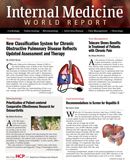Publication
Article
Internal Medicine World Report
Updated Guidelines for Clinicians to Prevent HIV Transmission
Author(s):
The International Antiviral Society–USA Panel has released its 2014 report, which provided clinical recommendations to stop HIV transmission.

The International Antiviral Society—USA Panel has released its 2014 report, which provided clinical recommendations to stop HIV transmission.
While HIV-1 infections have dropped by 33% worldwide since 2001, the researchers claimed the infection rate is still unacceptably high. They also mentioned a previous study that found the infection rate in the US hasn’t changed since the 1990s.
To tackle HIV transmission among adults and adolescents, the panel members reviewed data and presentation abstracts published within the last 17 years. They restricted their recommendations to non-pregnant individuals.
As a result of the systematic review, the following recommendations were provided as top priorities for clinicians:
â— 1-time HIV testing for all adolescents and adults
â— More frequent HIV testing for at-risk individuals
â— Acute testing for persons suspected to have HIV
â— Timely implementation of antiretroviral therapy for HIV-positive individuals
â— Providing accessible therapy, partner notification methods, and STI screening for HIV patients
â— Needle exchange programs for drug injectors
â— Immediate post-exposure prophylaxis treatment for anyone who is exposed to HIV
â— Voluntary circumcision for males living in high risk areas
Concerning testing, the authors recommended utilizing high performing tests with high sensitivity and specificity. Tests yielding quick results should be used for individuals not likely to return for their results, and panel members suggested providing additional accommodations for testing couples.
Previously, preventative measures for HIV were associated with behavioral intervention. However, they members recommended an overall approach incorporating behavioral and biomedical approaches.
While the authors mentioned the importance of early care, they suggested more research needs to be conducted to provide methods on how to further increase access to care and reduce barriers.
Concluding the report, the panel members hope the increase of access in ART and viral suppression will deem HIV positive individuals noninfectious. Furthermore, researchers implore high risk persons be treated with its wide range of proposed guidelines.
“These biomedical interventions can be productively complemented by appropriate behavioral and structural interventions and support services,” the authors wrote. “Clinicians are crucial in implementing these interventions, and should use evidence-based HIV prevention tools.”






